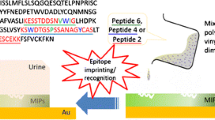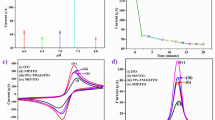Abstract
This study determined isomeric molecules by employing molecular imprinting technology (MIP) and electrochemical impedance spectroscopy (EIS). In order to increase surface area to obtain more sensitive sensor technology, ex situ precipitation polymerization was carried out to produce microspheres. These microspheres were placed on pyrrole-modified carbon electrodes. Acrylamide, as monomer, was polymerized by cross-linker trimethylolpropane trimethacrylate (TRIM) and Azobisisobutyronitrile (AIBN) as initiator and as template molecules; chondroitin sulfate (CS) and dermatane sulfate (DS) were used. Performances of the electrodes were determined as follows, CS and DS sensor, respectively; calibration curves were calculated between 50 to 500 ng/mL and 50 to 600 ng, R2 = 0.9942 ± 0.0029 and R2 = 0.9824 ± 0.0083, LOD and LOQ were 15.19 ng/mL, 46.03 ng/mL, and 32.56 ng/mL, 102.82 ng/mL, respectively. The characterization of polymers was carried out by X-ray photoelectron spectroscopy (XPS), Fourier Transform Infrared (FTIR), and Scanning Electron Microscopy (SEM). The applicability of the optimized sensor systems to real samples was examined in urine samples and the systems were tested by LC–MS/MS method. Sensors showed a good correlation with tandem mass spectrometry.




Similar content being viewed by others
Data Availability
The authors declare that all data can be shared and accessed by the permission of the journal publication rules. The data underlying this article are available in the article and in its online supplementary material.
References
Rajabi, H. R., Roushani, M., & Shamsipur, M. (2013). Development of a highly selective voltammetric sensor for nanomolar detection of mercury ions using glassy carbon electrode modified with a novel ion imprinted polymeric nanobeads and multi-wall carbon nanotubes. Journal of Electroanalytical Chemistry, 693, 16–22. https://doi.org/10.1016/j.jelechem.2013.01.003
Haupt, K., & Mosbach, K. (2000). Molecularly ımprinted polymers and their use in biomimetic sensors. Chemical Reviews, 100, 2495–2504. https://doi.org/10.1021/cr990099w
Ye, L., & Mosbach, K. (2001). Molecularly imprinted microspheres as antibody binding mimics. Reactive & Functional Polymers, 48, 149–157. https://doi.org/10.1016/S1381-5148(01)00050-5
Uygun, Z. O., Okutucu, B., Hacikara, Ş, & Saǧin, F. (2019). Development of molecularly imprinted Acrylamide- Acrylamido phenylboronic acid copolymer microbeads for selective glycosaminoglycan separation in children urine. Turkish J. Biochem., 44, 738–744. https://doi.org/10.1515/tjb-2018-0413
ErtuğruL, H. D., & Uygun, Z. O. (2013). Impedimetric biosensors for label-free and enzymless detection, state of the Art in Biosensors - General Aspects, Toonika Rinken, IntechOpen. https://doi.org/10.5772/52169. Available from: https://www.intechopen.com/chapters/41912
Parmpi, P., & Kofinas, P. (2004). Biomimetic glucose recognition using molecularly imprinted polymer hydrogels. https://doi.org/10.1016/j.biomaterials.2003.08.025
Whitley, C. B., Ridnour, M. D., Draper, K. A., Dutton, C. M., & Neglia, J. P. (1989). Diagnostic test for mucopolysaccharidosis. I. Direct method for quantifying excessive urinary glycosaminoglycan excretion. Clinical Chemistry, 35(3), 374–379
Terho, T. T., & Hartiala, K. (1971). Method for determination of the sulfate content of glycosaminoglycans. Analytical Biochemistry, 41, 471–476. https://doi.org/10.1016/0003-2697(71)90167-9
Berry, H. K. (1987). Screening for mucopolysaccharide disorders with the Berry spot test. Clinical bBiochemistry, 20, 365–371. https://doi.org/10.1016/S0009-9120(87)80088-7
Maccari, F., & Volpi, N. (2002). Glycosaminoglycan blotting on nitrocellulose membranes treated with cetylpyridinium chloride after agarose-gel electrophoretic separation. Electrophoresis, 23, 3270–3277. https://doi.org/10.1002/1522-2683(200210)23:19%3c3270::AID-ELPS3270%3e3.0.CO;2-I
Yang, B., Solakyildirim, K., Chang, Y., & Linhardt, R. J. (2011). Hyphenated techniques for the analysis of heparin and heparan sulfate. Analytical and Bioanalytical Chemistry, 399, 541–557. https://doi.org/10.1007/s00216-010-4117-6
Silvestro, L., Tarcomnicu, I., & Savu, S. R. (2008). HPLC-MS/MS of highly polar compounds. Tandem Mass Spectrometry-Applications and Principles. https://doi.org/10.5772/33129
Uygun, Z. O., & Dilgin, Y. (2013). A novel impedimetric sensor based on molecularly imprinted polypyrrole modified pencil graphite electrode for trace level determination of chlorpyrifos. Sensors Actuators, B Chem., 188, 78–84. https://doi.org/10.1016/j.snb.2013.06.075
Atar, N., Yola, M. L., & Eren, T. (2016). Sensitive determination of citrinin based on molecular imprinted electrochemical sensor. Applied Surface Science, 362, 315–322. https://doi.org/10.1016/j.apsusc.2015.11.222
Randles, J. E. B. (1947). Kinetics of rapid electrode reactions. Discussions of the Faraday Society, 1, 11. https://doi.org/10.1039/df9470100011
Oguma, T., Tomatsu, S., Montano, A. M., & Okazaki, O. (2007). Analytical method for the determination of disaccharides derived from keratan, heparan, and dermatan sulfates in human serum and plasma by high-performance liquid chromatography/turbo ionspray ionization tandem mass spectrometry. Analytical Biochemistry, 368, 79–86. https://doi.org/10.1016/j.ab.2007.05.016
Ye, L., Weiss, R., & Mosbach, K. (2000). Synthesis and characterization of molecularly ımprinted microspheres. Macromolecules, 33, 8239–8245. https://doi.org/10.1021/ma000825t
Abdelkader, R., & Mohammed, B. (2016). Green synthesis of cationic polyacrylamide composite catalyzed by an ecologically catalyst clay called maghnite-H+ (Algerian MMT) under microwave irradiation. Bull. Chem. React. Eng. Catal., 11, 170–175. https://doi.org/10.9767/bcrec.11.2.543.170-175
Turco, A., Corvaglia, S., Mazzotta, E., Pompa, P. P., & Malitesta, C. (2018). Preparation and characterization of molecularly imprinted mussel inspired film as antifouling and selective layer for electrochemical detection of sulfamethoxazole. Sensors Actuators, B Chem., 255, 3374–3383. https://doi.org/10.1016/j.snb.2017.09.164
Uygun, Z. O., & Ertuğrul Uygun, H. D. (2014). A short footnote: Circuit design for faradaic impedimetric sensors and biosensors. Sensors and Actuators B: Chemistry, 202, 448–453. https://doi.org/10.1016/j.snb.2014.05.029
Acknowledgements
We authors thanks to Dokuz Eylül University Center for Fabrication and Application of Electronic Materials.
Author information
Authors and Affiliations
Contributions
Hilmiye Deniz Ertuğrul Uygun: conceptualization, methodology, software, writing—original draft preparation, revision, methodology. Nihat Tınkılıç: reviewing and editing.
Corresponding author
Ethics declarations
Ethics Approval
This study was approved by Ege University Ethical Committee by the consent number of 20–2.1 T/36.
Consent to Participate
Authors consent to participate with no conflict of interest.
Consent for Publication
Authors consent to publish with no conflict of interest.
Competing Interests
The authors declare no competing interests.
Additional information
Publisher’s Note
Springer Nature remains neutral with regard to jurisdictional claims in published maps and institutional affiliations.
Supplementary Information
Below is the link to the electronic supplementary material.
Rights and permissions
About this article
Cite this article
Ertuğrul Uygun, H.D., Tinkiliç, N. Molecularly Imprinted Microspheres-Modified Impedimetric Sensor Systems for Distinguished Determination of Glycosaminoglycan. Appl Biochem Biotechnol 194, 659–670 (2022). https://doi.org/10.1007/s12010-021-03644-3
Received:
Accepted:
Published:
Issue Date:
DOI: https://doi.org/10.1007/s12010-021-03644-3




